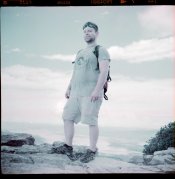Racking my brain trying to figure out what the problem is here.
Originally, I purchased some raw chemicals and mixed up a batch of c41 developer. I used some kodak bleach that I got on sale from a canadian vendor and some ammonium thiosulfate fixer diluted to the correct concentration. 3min15 sec for dev, wash, 6.5 min for bleach, wash, 6.5 min fix. all at 100*F.
First film came out wonky. Negatives too dense, colours off, I couldn't scan or wet print them properly.
Thinking the problem was my developer, I then purchased some official kodak LORR developer. Similar problem with the next roll of film in new developer.
I'm wondering, could it be the fixer or the bleach now? And are the negatives savlageable if I reprocess them? The bleach is kodak bleach replenisher, this stuff:
https://www.bhphotovideo.com/c/product/27627-REG/Kodak_8255549_Flexicolor_RA_C_41RA_Bleach.html
Intended to be used in minilabs with higher agitation and washeless. I figured I could use in a dev tank with high agitation. And washed anyways prior to bleaching as I didn't want the bleach to eat the dev. It says something on the label about a bleach starter, but I can't find that anywhere? The fixer is photographers formulary stuff. Perhaps it went bad.
What do you folks think? I was expecting better results from a non-blix process. I'd prefer not to mix up several more chemicals and waste more film.
Originally, I purchased some raw chemicals and mixed up a batch of c41 developer. I used some kodak bleach that I got on sale from a canadian vendor and some ammonium thiosulfate fixer diluted to the correct concentration. 3min15 sec for dev, wash, 6.5 min for bleach, wash, 6.5 min fix. all at 100*F.
First film came out wonky. Negatives too dense, colours off, I couldn't scan or wet print them properly.
Thinking the problem was my developer, I then purchased some official kodak LORR developer. Similar problem with the next roll of film in new developer.
I'm wondering, could it be the fixer or the bleach now? And are the negatives savlageable if I reprocess them? The bleach is kodak bleach replenisher, this stuff:
https://www.bhphotovideo.com/c/product/27627-REG/Kodak_8255549_Flexicolor_RA_C_41RA_Bleach.html
Intended to be used in minilabs with higher agitation and washeless. I figured I could use in a dev tank with high agitation. And washed anyways prior to bleaching as I didn't want the bleach to eat the dev. It says something on the label about a bleach starter, but I can't find that anywhere? The fixer is photographers formulary stuff. Perhaps it went bad.
What do you folks think? I was expecting better results from a non-blix process. I'd prefer not to mix up several more chemicals and waste more film.
Last edited:








 postive_001
postive_001 crossover
crossover positive
positive


 .
.

 postive_strip001
postive_strip001